
Cardiology / English / General propedeutics of internal diseases_Nemtsov-LM_2016
.pdf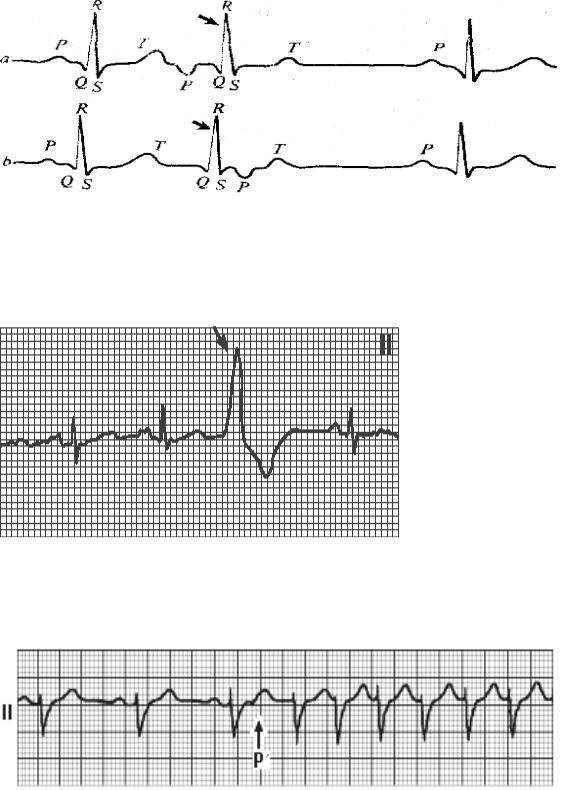
Fig. Suppl. 18. Atrioventricular (nodal) extrasystole:
(1) premature appearance of the cardiac complex; (2) negative P wave because of the retrograde atrial excitation; (3) the position of the P wave with respect to the ventricular complex depends on the rate of propagation of the excitation wave onto the atria and the ventricles;(4) shape of QRS is normal or slightly deformed;
(5) incomplete compensatory pause
Fig. Suppl. 19. Ventricular extrasystole:
(1) premature appearance of the ventricular complex; (2) absence of the P wave;
(3) deformation of the QRS complex due to its increased voltage and length; (4) the shape and the height of the T wave changes, its direction is opposite to the maximum wave of the QRS complex; (5) сomplete compensatory pause
Fig. Suppl. 20. Initiation of the atrioventricular nodal paroxysmal tachycardia
(reentry tachycardia - abnormal P wave and the atrioventricular nodal delay (long PR)
170
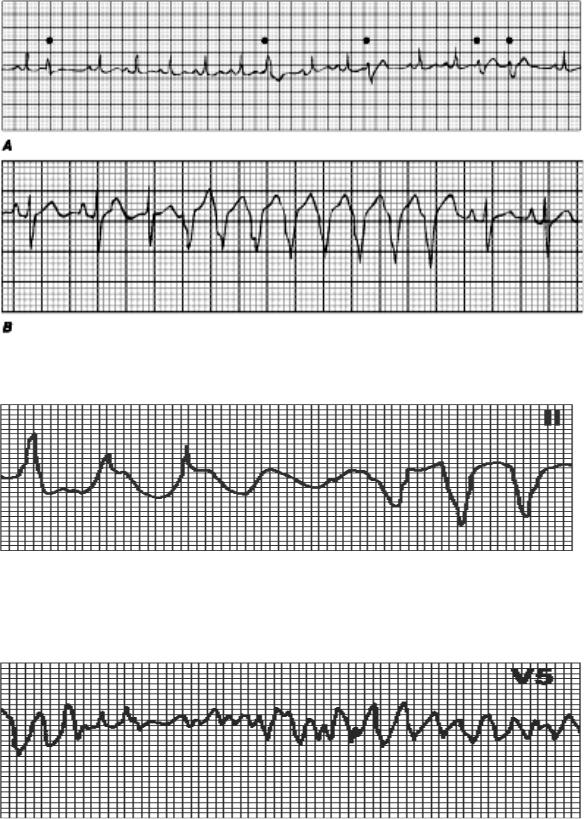
Fig. Suppl. 21. Ventricular paroxysmal tachycardia: A- Frequent ventricular extrasystoles precede PT; B- Episode of ventricular PT (at the same patient).
Fig. Suppl. 22. Torsade de pointes:
Ventricular PT characterized by the continuously changing QRS, may be as predictor of ventricular fibrillation and cardiac arrest.
Fig. Suppl. 23. Ventricular fibrillation:
A rapid irregular ventricular rhythm due to multiple reentrant activity associated with essentially zero cardiac output.
171
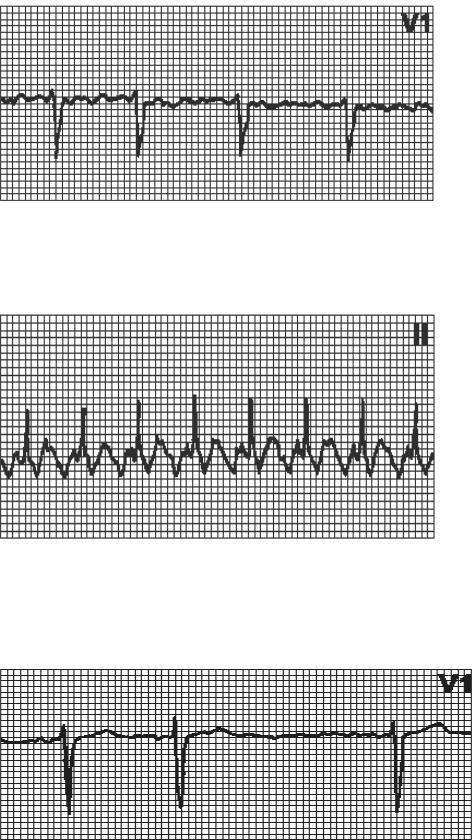
Fig. Suppl. 24. Atrial fibrillation:
(1) P wave disappears; (2) multiple small irregular f waves; (3) QRS ventricular complexes follow are irregular, their shape does not change.
Fig. Suppl. 25. Atrial flutter:
(1) high F waves instead of the normal atrial P waves; (2) the number of F waves preceding each ventricular complex depends on the AV conduction; (3) QRS complexes follow at regular intervals.
Fig. Suppl. 26. Sino-atrial block:
(1) periodic missing of the heart complex (PQRST) in the presence of a regular sinus rhythm; (2) the length of diastole doubles.
172

Fig. Suppl. 27. Intra-atrial block:
(1)P waves are broadened ≥0.11 s and splitted;
(2)P wave in the V1 lead has two phases.
Fig. Suppl. 28. I degree of atrioventricular block:
(1)increased P-Q interval (> 0.21 s to 0.3-0.4 s and more) without missing QRS;
(2)regular heart rhythm.
Fig. Suppl. 29. II degree of atrioventricular block with Samoilov-Wenckebach periods (Mobitz-1 type):
(2)gradual elongation PQ (Samoilov-Wenckebach periods);
(3)periodically missing ventricular contractions
173
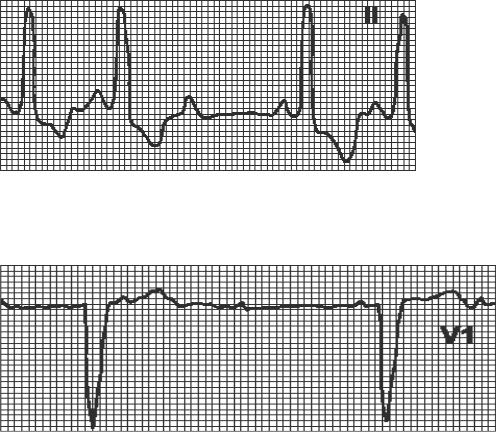
Fig. Suppl. 30. II degree of atrioventricular block (Mobitz-2 type):
(1)periodic missing QRS without gradual elongation PQ (2:1);
(2)PQ can be normal or a little bit prolonged
Fig. Suppl. 31. III degree of atrioventricular block (complete heart block):
(1)atrial P waves and ventricular complexes QRS are recorded independently of each other;
(2)the number of QRS is usually much smaller than the number of atrial P waves;
(3)the shape of the ventricular complex does not change if the pacemaker arises from the AV node or His bundle;
(4)with lower location of the pacemaker in the conduction system, the QRST complexes are altered.
174
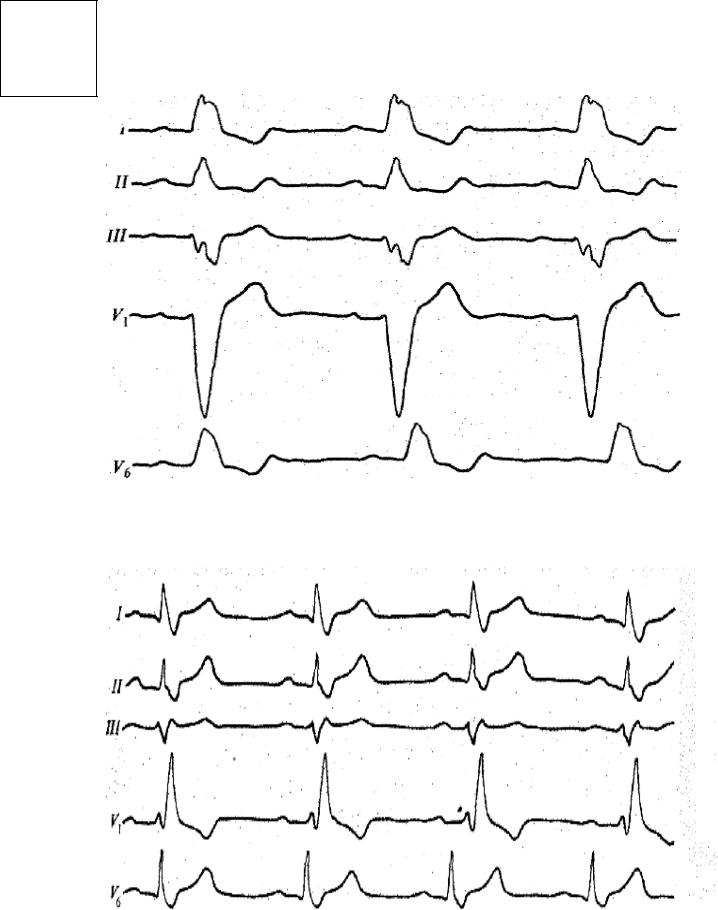
Fig. Suppl. 32. Left bundle branch block:
(1)wide and deformed QRS has the form of qR in I,II, V5-6; rS in III, aVF, V1-2 ;
(2)disconcordance of ST,T and the main wave of QRS; (3) levogram
Fig. Suppl. 33. Right bundle branch block:
(1)wide QRS III, V1-2 has the form of rsR, rSR, RsR´(similar to “M”);
(2)wide S I, aVL,V5-6; (3) negative ST and T in V1-2; (4) dextrogram
175
Учебное издание
Составитель: Немцов Леонид Михайлович
GENERAL PROPEDEUTICS OF INTERNAL DISEASES (ОБЩАЯ ПРОПЕДЕВТИКА ВНУТРЕННИХ БОЛЕЗНЕЙ)
Курс лекций
(на английском языке) (2-е издание)
Редактор Г.И. Юпатов Технический редактор И.А. Борисов Компьютерная верстка Л.М. Немцов
Корректор Л.М. Немцов
Подписано в печать _________. Формат бумаги 64×84 1/16. Бумага типографская №2. Гарнитура ТАЙМС. Усл. печ. листов ____. Уч.-изд. л. ____. Тираж ______экз. Заказ №______.
Издатель и полиграфическое исполнение УО «Витебский государственный медицинский университет»
ЛП №02330/453 от 30.12.2013 г. Пр-т Фрунзе, 27, 210602, г. Витебск
